Extra News Alerts
Get breaking updates as they happen.

Vermont’s landscapes are home to a wide variety of wildlife. While the state’s natural beauty attracts outdoor enthusiasts year-round, it also harbors a number of animals that can pose dangers to humans and pets. From the towering moose that roam the northern woodlands to the venomous Eastern timber rattlesnake hidden in rocky outcrops, the fauna in Vermont includes species capable of inflicting serious harm. These ten are the most deadly.
The American black bear is one of the largest omnivorous mammals found in Vermont’s forests and mountainous regions. With a coat that can range from jet black to a lighter brown or cinnamon, these bears are easily identifiable by their broad heads, small, rounded ears, and stocky bodies. Black bears in Vermont are primarily found in remote forested areas, particularly in the Green Mountains and along the Appalachian Trail, where they forage for berries, nuts, and insects.
What makes black bears deadly is their sheer strength and unpredictable behavior when they feel threatened. While attacks on humans are rare, they can be triggered if a bear feels its cubs are in danger or if it is surprised at close range. In such cases, the bear may become aggressive, and its powerful jaws and sharp claws can inflict serious injuries and death.
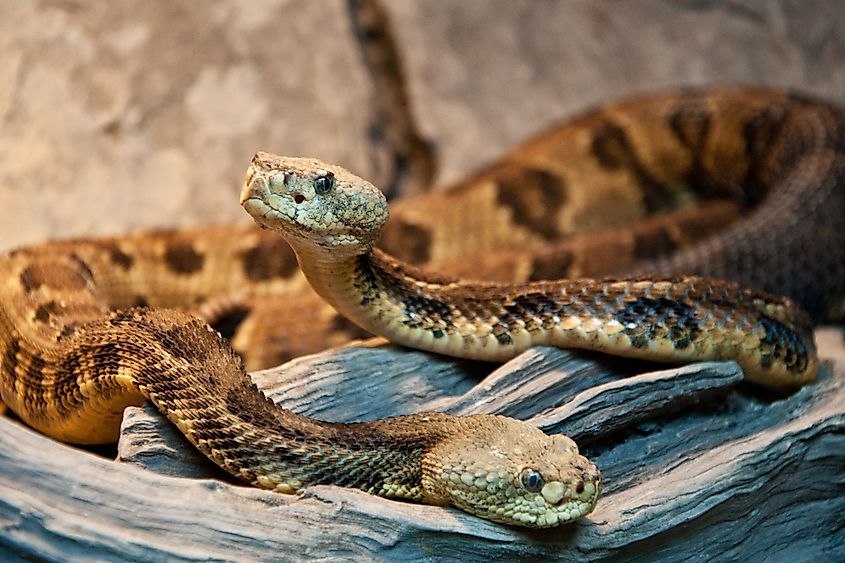
The Eastern timber rattlesnake is one of Vermont’s few venomous reptiles, recognizable by its thick, muscular body and distinctive dark crossbands over a yellow, brown, or gray background. These snakes are endangered and rare to see in the state. They typically reside in remote, rocky hillsides, forests, and ledges in southern Vermont, preferring areas that offer plenty of sun exposure for basking.
Despite their elusive nature, timber rattlesnakes are highly dangerous due to their potent venom. A bite from this snake can result in severe pain, swelling, and even death if not treated promptly. The rattlesnake’s warning rattle is often the first sign of its presence, but if this signal is ignored or if the snake feels cornered, it may strike in self-defense. While fatalities are rare with modern medical treatment, the risk of a deadly encounter is real, particularly for hikers who may inadvertently come across these camouflaged serpents.
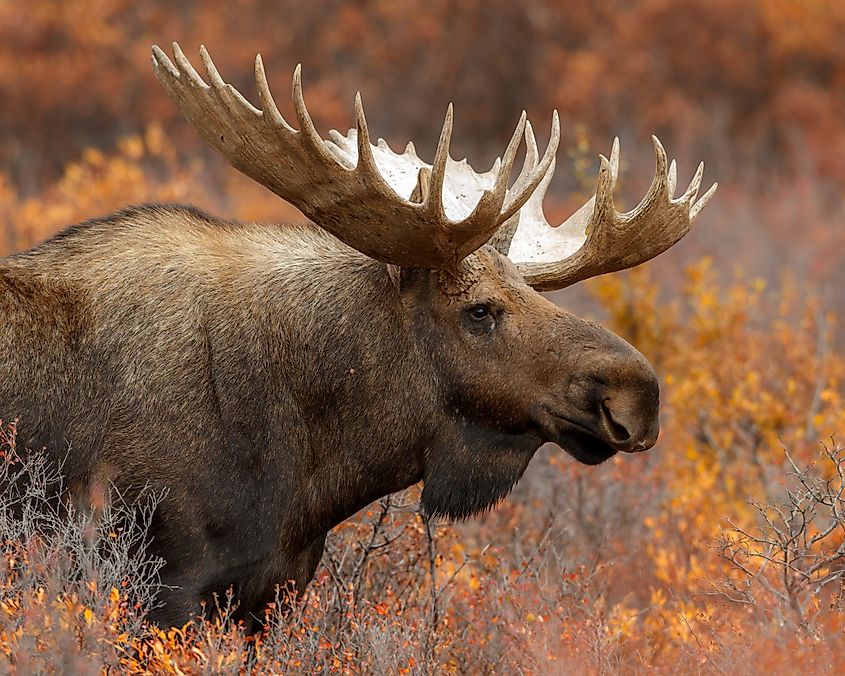
Moose are the largest animals in Vermont, towering over the landscape with their long legs, humped shoulders, and massive antlers that can span several feet across. These creatures are commonly found in Vermont’s northern forests, wetlands, and along remote roads, particularly in areas like the Northeast Kingdom. Their dark brown coats, long faces, and stature make them an iconic symbol of the state’s wildlife.
Despite their generally calm demeanor, moose are dangerous due to their size. Moose are known to charge when they feel threatened, particularly during the rutting season in the fall or when cows are protecting their calves. A charging moose can easily trample or gore with its antlers, posing a significant threat to humans.
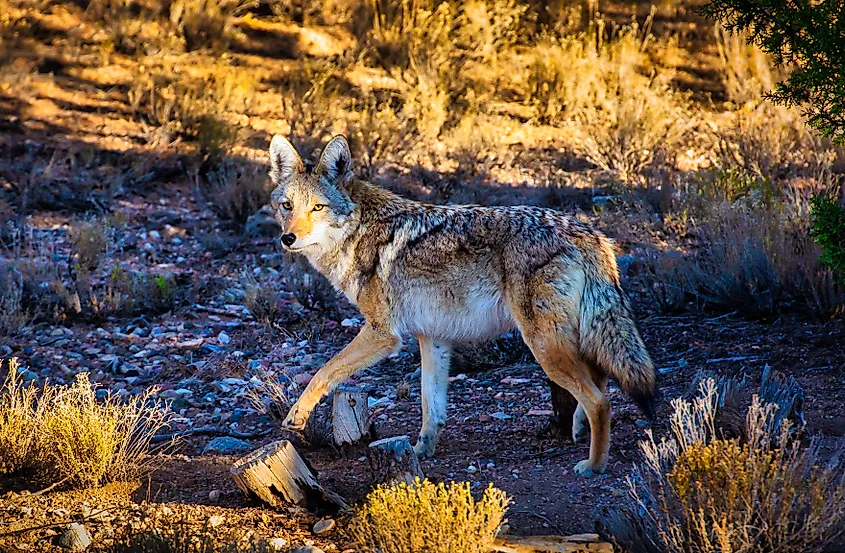
Coyotes are highly adaptable predators found throughout Vermont, from the rural countryside to the edges of suburban areas. They resemble small wolves with slender bodies, bushy tails, and a coat that range from grayish-brown to reddish-brown. Coyotes often hunt in pairs or small family units.
Coyotes can become a threat, especially if they lose their fear of people or are protecting a den with pups. Coyotes are opportunistic feeders and may attack and kill small pets or livestock, particularly during the winter months when food is scarce. In rare cases, coyotes have been known to act aggressively toward humans, especially if they are habituated to human food sources.
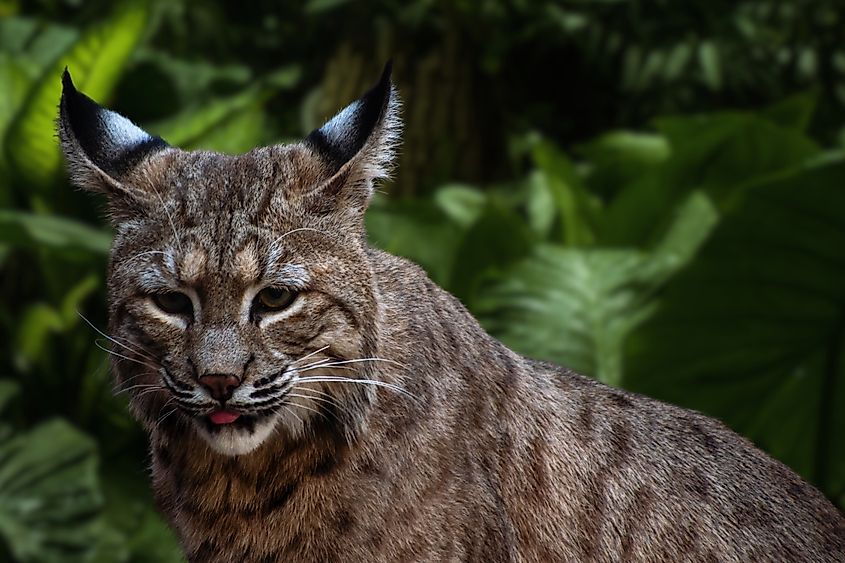
Bobcats are predators native to Vermont, characterized by their short “bobbed” tails, tufted ears, and spotted coats. These medium-sized wildcats inhabit forests, swamps, and rocky outcroppings across the state, where they are rarely seen due to their solitary and nocturnal habits.
Although bobcats are not typically aggressive toward humans, they also can pose a danger to pets and livestock. If cornered or threatened, a bobcat may defend itself with sharp claws and powerful bites, which can cause serious injuries. Additionally, bobcats are carriers of diseases like rabies and feline distemper, which can be transmitted to pets and potentially humans. Their agility and strength make them formidable opponents if provoked.
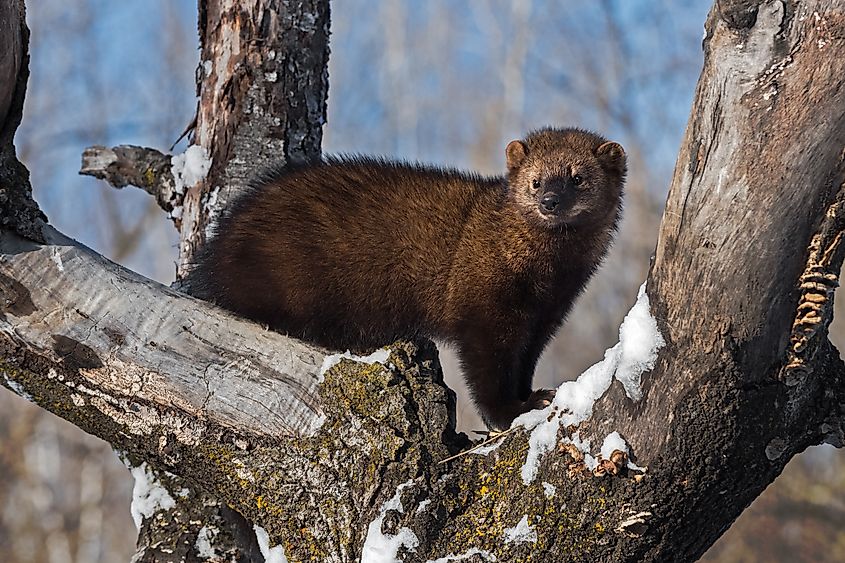
The fisher cat, a member of the weasel family, is found in Vermont’s forests, particularly in the more densely wooded areas. Despite its name, the fisher is not a cat but a sleek, dark-furred carnivore with a long body and bushy tail. They are highly skilled climbers and hunters, preying on small mammals like squirrels, rabbits, and even porcupines, making them one of the few predators capable of tackling such prickly prey.
Fisher cats are known for their aggressive behavior and can be dangerous, especially to domestic animals like cats and small dogs. Their sharp teeth and claws make them formidable, and they often strike without warning. Their high-pitched scream, often heard at night, adds to their reputation.
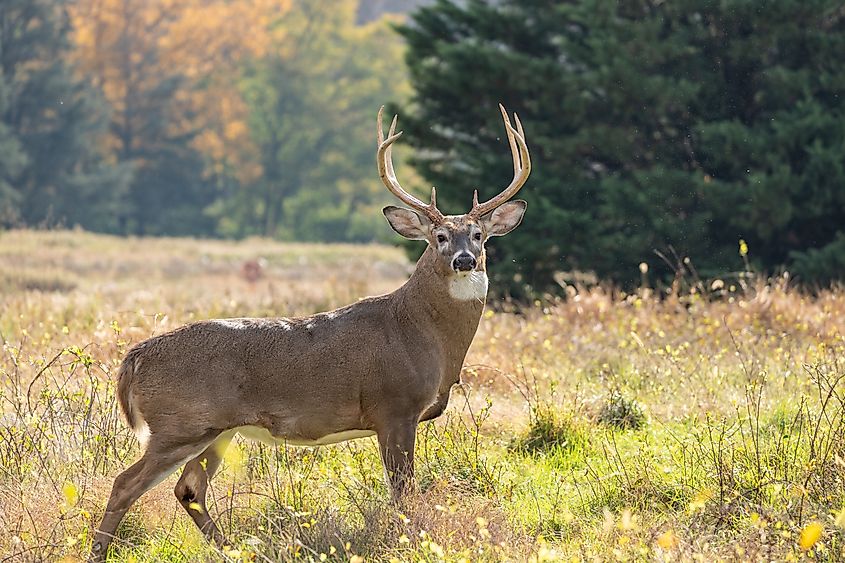
White-tailed deer are one of the most common and recognizable animals in Vermont, found in forests, fields, and even suburban areas across the state. These graceful creatures are identified by their reddish-brown coats in summer, which turn grayish in winter, and the distinctive white underside of their tails, which they raise when alarmed. Deer are a frequent sight throughout Vermont, often seen grazing at dawn and dusk.
While deer are not aggressive, they are responsible for a significant number of road accidents, particularly in the fall during the breeding season, known as the rut. These accidents can be deadly, as a collision with a full-grown deer can cause serious damage to vehicles and result in severe injuries or fatalities for the occupants. Thus, while they might not be dangerous in the traditional sense, the risks associated with white-tailed deer are nonetheless significant.
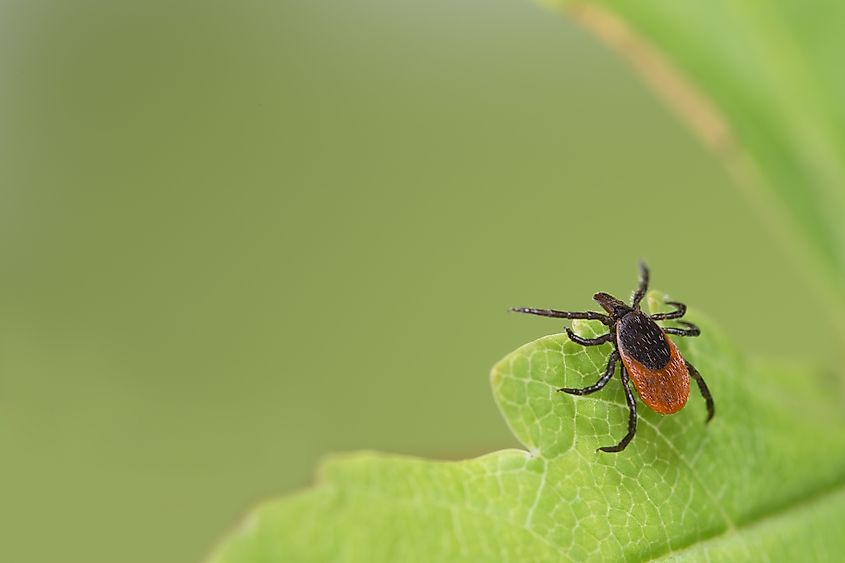
The black-legged tick, also known as the deer tick, is a tiny arachnid found throughout Vermont, particularly in wooded areas, grassy fields, and along hiking trails. These ticks are most active from spring through fall, lurking on low vegetation where they latch onto passing animals or humans. Adult black-legged ticks are about the size of a sesame seed, with a reddish body and black legs.
What makes black-legged ticks deadly is their ability to transmit Lyme disease, a serious and potentially chronic illness. When an infected tick bites, it can transmit the bacteria that causes Lyme disease into the bloodstream. Early symptoms include fever, fatigue, and a distinctive bullseye-shaped rash, but if left untreated, Lyme disease can lead to severe neurological, cardiac, and joint issues.
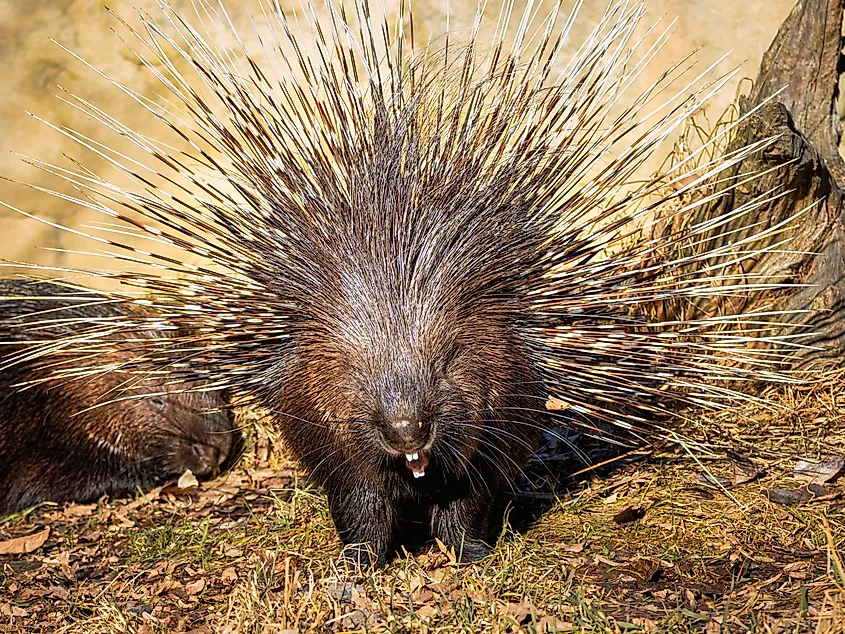
Porcupines are easily recognizable due to their spiky quills and are found throughout Vermont’s forests and woodlands. These nocturnal rodents are slow-moving and tend to climb trees in search of food, mainly feeding on bark, leaves, and twigs. Porcupines are well-equipped to defend themselves with thousands of sharp quills that cover their backs and tails. Their quills lie flat until the animal feels threatened, at which point they are raised in defense.
While porcupines are not deadly to humans, they can be lethal to pets, particularly curious dogs who may try to engage with them. A single swipe of the porcupine’s tail can embed dozens of quills into the skin of an attacker. These quills are barbed and can work their way deeper into the flesh over time, causing severe pain and infections.
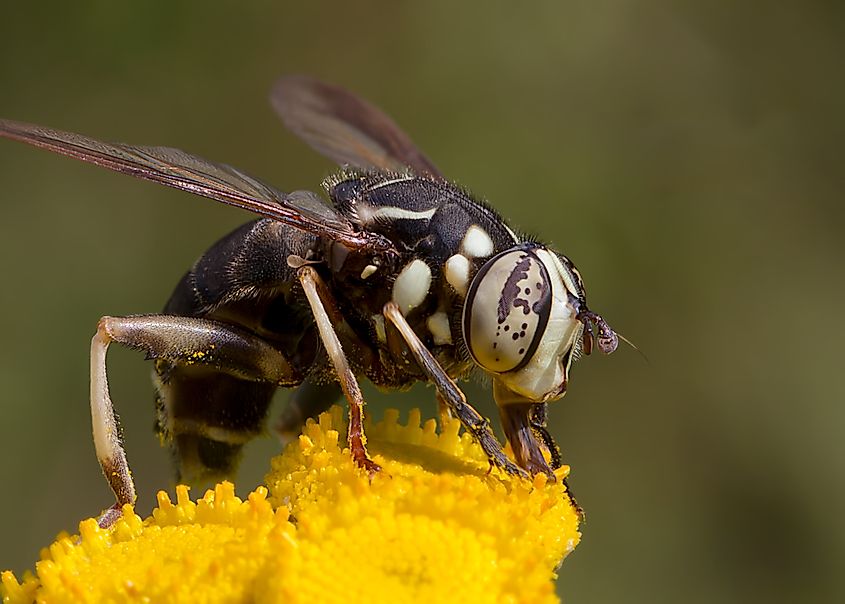
The bald-faced hornet, despite its name, is not a true hornet but a species of yellowjacket wasp commonly found throughout Vermont. These insects are easily identified by their black bodies with white markings on their face and thorax. They build large, paper-like nests in trees, shrubs, or under eaves, which can contain hundreds of workers. Bald-faced hornets are most active during the late summer and early fall when they become particularly defensive of their nests.
Unlike bees, these bald-faced hornets can sting repeatedly, injecting venom that causes intense pain and swelling. For those who are allergic to insect stings, a bald-faced hornet attack can quickly become life-threatening, leading to anaphylactic shock if not treated immediately. Even in non-allergic individuals, multiple stings can cause significant discomfort and require medical attention. Their nests, often hidden from view until disturbed, make accidental encounters dangerous, especially for outdoor workers or hikers.
While Vermont is often celebrated for its wilderness, it is important to remember that even in this setting, certain animals pose real dangers. Whether it’s the unpredictable aggression of a startled black bear, the silent threat of a black-legged tick carrying Lyme disease, or the sudden sting of a bald-faced hornet, these creatures remind us that nature, though beautiful, can also be perilous. Awareness and respect for the wildlife around us are key to safely navigating the state’s diverse ecosystems.


Nine of the Vermont Senate’s 11 standing committees will have new leaders this biennium and three will be helmed by Republicans, Lt. Gov. John Rodgers announced from the Senate floor Thursday afternoon.
The committee overhaul follows the retirement, death or defeat of a considerable number of veteran chairs last year — and after Republicans picked up six seats in the 30-member body in November’s election. Democrats and Progressives now hold 17 seats, while Republicans control 13.
Unlike the Vermont House, where committee positions are chosen unilaterally by the speaker, Senate assignments are doled out by a three-member panel, the Committee on Committees, which this year includes two new participants: Rodgers, a Republican, and Sen. Ginny Lyons, D-Chittenden Southeast. Senate President Pro Tempore Phil Baruth, D/P-Chittenden Central, returned to the committee.
The trio had few experienced senators from which to choose, given that — as Baruth noted in his opening remarks to the chamber Wednesday — nearly two-thirds of the Senate’s members joined the body over the past two years. Illustrating the point, newly sworn-in Sen. Seth Bongartz, D-Bennington, was tapped to chair the Senate Education Committee. (Bongartz had previously served in the House since 2021 — and had tours of duty in both the House and Senate in the 1980s.)
Perhaps the most significant appointment went to Sen. Andrew Perchlik, D/P-Washington, who will chair the powerful Senate Appropriations Committee. He succeeds Sen. Jane Kitchel, D-Caledonia, who retired after leading the budget-writing panel for 14 years.
Sen. Nader Hashim, D-Windham, will helm the Senate Judiciary Committee, following the death last June of veteran Sen. Dick Sears, D-Bennington.
The Senate Natural Resources & Energy Committee will be led by Sen. Anne Watson, D/P-Washington. Its former chair, Sen. Chris Bray, D-Addison, was defeated in November.

Sen. Alison Clarkson, D-Windsor, takes over the Senate Economic Development, Housing & General Affairs Committee from Sen. Kesha Ram Hinsdale, D-Chittenden Southeast. Ram Hinsdale defeated Clarkson for the role of Senate majority leader in November, requiring the former to step down from her committee leadership position and allowing the latter to step up.
The three Republicans chairing panels are Sen. Richard Westman, R-Lamoille, who will run the Senate Transportation Committee; Sen. Russ Ingalls, R-Essex, who will head the Senate Agriculture Committee; and Sen. Brian Collamore, R-Rutland, who will lead the Senate Government Operations Committee. (Republicans similarly made gains in House leadership positions this year.)
Sen. Wendy Harrison, D-Windham, takes over the Senate Institutions Committee from Ingalls, who chaired it last biennium.
The sole returning chairs are Lyons, who will continue to lead the Senate Health & Welfare Committee, and Sen. Ann Cummings, D-Washington, who will retain control of the Senate Finance Committee.
Speaking to reporters Thursday afternoon, Baruth said the Committee on Committees had intentionally sought partisan equilibrium on certain panels. The Senate Education Committee, for example, which is expected to engage in heavy lifting as lawmakers reconsider the state’s education funding scheme, includes three Democrats and three Republicans. For a bill to clear that panel, four members would have to approve.
“What I intended for that committee… to do is to put out bipartisan bills,” Baruth said of Senate Ed.
Similarly, Baruth called the composition of the tax-writing Senate Finance Committee “very centrist,” with four Democrats and three Republicans.
“They’re going to have a lot of work to do, hard work, but the one thing I want them to think — to think long and hard about — is any kind of raising taxes or fees,” Baruth said. “The only time I’m looking to do that, if it’s necessary, is if it brings down the property tax.”
Ethan Weinstein contributed reporting.

This article will be updated.
Gov. Phil Scott proposed a sweeping overhaul of what he called Vermont’s “broken and failing” education funding and governing systems during his inaugural address Thursday.
In his first major speech since voters overwhelmingly reelected him and booted Democrats up and down the ballot from office, Scott focused on the topic that most infuriated Vermonters in November: affordability.
“When it comes to politics, I know it can be hard to admit when you’ve gone down the wrong path and need to turn around,” Scott told House and Senate lawmakers during his fifth inaugural address at the Statehouse in Montpelier. “But we’re not here to worry about egos. We’re here to do what Vermonters need. And they just sent a very clear message: They think we’re off course.”
As is typical for an inaugural speech, Scott did not delve into specifics on Thursday — the details of his plan will be unveiled later this month during his budget address.
But in the broad strokes, Scott teased a plan that would overhaul Vermont’s byzantine school governance structure and see the state assume a direct role in deciding how much districts spend.
“The bottom line is our system is out of scale and very expensive,” Scott said. “And as obvious as these challenges are, we haven’t been able to fix it.”
At the heart of Scott’s vision is a transition to a so-called foundation formula, whereby the state would calculate how much districts should spend on their schools and provide them corresponding grants.
Currently, local voters decide how much their school districts should spend when they approve or reject budgets during Town Meeting Day in the spring. Whatever the amount, the state must pay. To calculate each town’s fair share into Vermont’s more than $2 billion education fund, residential property tax rates are adjusted based on how much each district is spending per pupil.
While potentially explosive in a state where local control is jealously guarded, a foundation formula is fairly typical across the country. And in Vermont, a bill to transition over to such a system even passed the House in 2018 with Democratic support. The architect of that 2018 legislation, then-GOP Rep. Scott Beck, was just elected to the Senate and named Republican minority leader for the chamber — where he is working closely with administration officials on their education plans.
Sophie Stephens
/
Vermont Public
“I think what we’re going to see [from the governor] here in a couple, three weeks is something that is far beyond just education finance,” Beck said in an interview Thursday. “I think it’s going to get into governance and delivery and outcomes.”
Beck said the transition to a foundation formula would force a series of questions, including whether districts would be allowed to approve any spending beyond the state’s base foundation grant.
“And in that case, where do they get that money from? And under what conditions can they access that money?” Beck said. “There’s a myriad of decisions that go into that whole thing. None of those decisions have been made. But I think in various circles, we have committed to going down the road of building a foundation formula in Vermont.”
Beck said he expects Scott’s education proposal will also include provisions that are designed to reduce staffing in the public education system.
When Scott first took office in 2016, the state spent about $1.6 billion annually on public schools. This year, that number will exceed $2.3 billion.
Vermont schools now have one staff person for every 3.63 students, the lowest ratio in the United States. In 2018, Scott pushed hard, and unsuccessfully, for legislation that would have instituted mandatory caps on staff-to-student ratios.
“With what we’re spending, we should not be in the middle of the pack on any educational scorecard,” Scott said. “And our kids should all be at grade level in reading and math. In some grades, less than half hit that mark. While educators, administrators, parents and kids are doing their very best to make things work, the statewide system is broken and failing them.”
Inaugural and state-of-the-state speeches tend to include a laundry list of policy ideas. But Scott’s 43-minute speech was focused almost entirely on education and housing — he renewed calls to trim development regulations and to bolster funding for rehabbing dilapidated homes.
Scott only briefly discussed last summer’s floods, and made glancing mentions of public safety, climate change, and health care. The governor, who voted for Vice President Kamala Harris in November, made no mention of President-elect Donald Trump or national politics.
Seeking to highlight some successes, the governor noted that overdose and traffic fatalities have declined recently, the state has welcomed more than 1,000 refugees in the past few years, and that the state park system saw near record visitation last year.
The governor has long argued that Chittenden County is prospering at a rate disproportionate to the rest of Vermont. He intensified that rhetoric in Thursday’s speech.
“As the rest of the state struggles to catch up, they carry the same burden of increasing taxes and fees and navigate the same complicated mandates and regulations,” the governor said. “And regardless of how well-intentioned these policies are, they’re expensive and require resources that places like Burlington, Shelburne and Williston may have, but small towns like Chelsea, Lunenburg, Peacham, Plainfield — and even Rutland, Newport or Brattleboro — do not. Too many bills are passed without considering the impact on these communities.”
Early in his speech, Scott paid tribute to several veteran legislators who died in the past year, including senators Bill Doyle and Dick Sears and representatives Don Turner, Bill Keogh, and Curt McCormack. Scott choked up and was visibly emotional when his recalling “my dear friend and mentor,” Sen. Dick Mazza, who died in May.
Former Governors Peter Shumlin, Jim Douglas and Madeleine Kunin attended the speech.
Subscribe to Capitol Recap, our weekly email newsletter featuring the latest headlines from the Statehouse.
Have questions, comments or tips? Send us a message.

Education
MORRISTOWN, Vt. (AP) — A Vermont school district’s inadequate response to serious and widespread harassment of Black and biracial students has led to a settlement agreement with the federal government, the U.S. Justice Department said Wednesday.
The department’s Civil Rights Division and the Vermont U.S. attorney’s office began investigating the Elmore-Morristown Unified Union School District in December 2023 and reviewed records and complaints from the previous three school years. Investigators concluded that students, primarily at the middle school level, faced frequent slurs and racist imagery, including the use of the N-word and displays of confederate flags and Nazi symbols.
“Racial harassment makes students feel unsafe, deprives them of a supportive educational environment and violates the Constitution’s most basic promise of equal protection,” Assistant Attorney General Kristen Clarke said in a statement. “We look forward to the district demonstrating to its students that racial bullying and harassment have no place in its schools.”
Superintendent Ryan Heraty said Wednesday those comments don’t reflect the district’s current reality given that there has been a dramatic decrease in such incidents.
“When students returned from the pandemic, we saw a significant increase in behavior at the middle level, which was deeply concerning,” he said in an email. “In response, we have taken many intentional actions to address this behavior, which the DOJ recognized in its review.”
In a letter to parents and other community members Tuesday, Heraty said the district stands firmly against any acts of racism and responds immediately to reported incidents. In the current academic year, there have been no reported incidents of race-based harassment at the district’s elementary school and a “very limited” number at the middle and high schools, he said.
The Justice Department said the district cooperated fully with the investigation and has already implemented some improvements, including adopting a central reporting system to track incidents. The district also agreed to revise anti-harassment policies and procedures, hold listening sessions with student groups and conduct formal training and education programs for students and staff.
Get breaking updates as they happen.


These are the top 7 issues facing the struggling restaurant industry in 2025


The 25 worst losses in college football history, including Baylor’s 2024 entry at Colorado


The top out-of-contract players available as free transfers: Kimmich, De Bruyne, Van Dijk…


New Orleans attacker had 'remote detonator' for explosives in French Quarter, Biden says


Carter's judicial picks reshaped the federal bench across the country


Who Are the Recipients of the Presidential Medal of Freedom?


Ozempic ‘microdosing’ is the new weight-loss trend: Should you try it?


Ivory Coast says French troops to leave country after decades